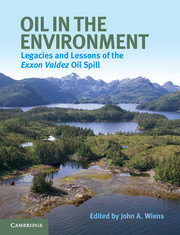Book contents
Prologue
Published online by Cambridge University Press: 05 July 2013
Summary
Shortly after midnight on March 24, 1989, the Tanker/Vessel Exxon Valdez, fully loaded with its cargo of Alaska North Slope crude oil, grounded on Bligh Reef in Prince William Sound, Alaska. Eight of its 11 cargo tanks ruptured, releasing some 11 million gallons (40million liters) of oil – about 20% of its cargo – into the icy waters of the Sound. The floating oil rapidly spread, pushed by strong coastal currents. Three days later, a severe winter storm moved in, widening and accelerating the spread of oil and thwarting attempts at containment. As the floating oil reached shorelines, it began coating beaches and intertidal algae and animals with layers of thick, black oil. Over 200 000 seabirds may have died. Commercial fisheries were closed. The spill eventually extended down the Kenai and Alaska peninsulas to beyond Kodiak Island, roughly the distance between Boston and Washington, District of Columbia.
It would be hard to imagine a worse place for an oil spill. Prince William Sound is widely regarded as pristine, and the remoteness and climate of the region present formidable challenges to mobilizing spill responses and cleanup. It supports large populations of charismatic wildlife: sea otters, seabirds, whales, bears, and seals. Tourism, cruises, recreation, and sport fishing are significant activities, and there are economically important commercial fisheries. Alaska Natives also rely heavily on the area for subsistence harvesting.
- Type
- Chapter
- Information
- Oil in the EnvironmentLegacies and Lessons of the Exxon Valdez Oil Spill, pp. xxii - xxviiPublisher: Cambridge University PressPrint publication year: 2013

